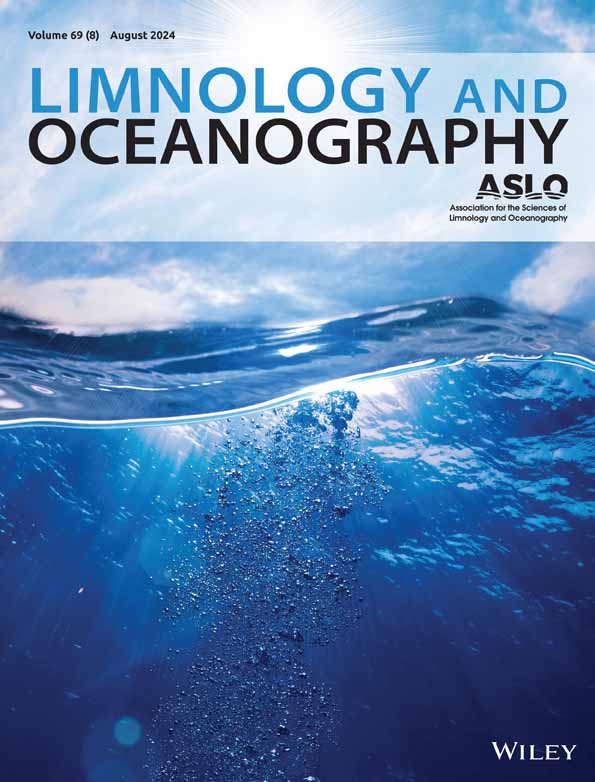亚热带边缘海纳米浮游植物群落的吞噬-混合营养活动
IF 3.8
1区 地球科学
Q1 LIMNOLOGY
引用次数: 0
摘要
越来越多的研究证明了浮游植物群落中吞噬-混合营养的生态重要性,特别是在开阔的海洋环境中。我们对这些浮游植物在边缘海域的分布和功能知之甚少。本研究对南海陆架-陆架样带的纳米真核浮游植物之间的吞噬-混合营养进行了研究,重点研究了裸生植物(Mamiellophyceae)和附生植物(Prymnesiophyceae)。我们使用酰胺信号放大荧光原位杂交测量了群体特异性放牧率,并评估了群落水平的无机养分(包括碳和氮)吸收率,以证明浮游植物的异养和自养生长能力。我们还使用相关分析、主成分分析、广义加性模型和结构方程模型来评估吞噬-混合营养活性与关键环境参数之间的相互关系,包括非生物因素(如温度、盐度、营养物)和生物因素(如细菌丰度)。我们的研究结果表明,在较低的盐度和较高的温度下,噬菌体-混合营养型哺乳动物更为丰富。放牧率与环境细菌丰度呈正相关。在营养物浓度低、光照强度高的站位,Prymnesiophyceae对细菌的掠食率最高,且与浮游植物对硝酸盐的吸收速率呈正相关。这些发现强调了吞噬-混合营养浮游植物自养和异养营养之间的动态相互作用,并证明了环境条件如何调节它们平衡光合作用和捕食细菌的能力。研究结果为研究副热带边缘海中吞噬-混合营养的生态作用及其对生物地球化学循环的贡献提供了有价值的见解。本文章由计算机程序翻译,如有差异,请以英文原文为准。
Phago‐mixotrophic activity within nanophytoplankton community in a subtropical marginal sea
An increasing number of studies have documented the ecological importance of phago‐mixotrophy within phytoplankton communities, especially in open ocean environments. We know less about the distribution and function of such phytoplankton within marginal seas. This study was an investigation of phago‐mixotrophy among nanoeukaryotic phytoplankton along a shelf‐to‐off‐shelf transect in the South China Sea with a focus on prasinophytes (Mamiellophyceae) and haptophytes (Prymnesiophyceae). We measured group‐specific grazing rates using tyramide signal amplified fluorescent in situ hybridization and assessed community‐level inorganic nutrient (including carbon and nitrogen) uptake rates to demonstrate the heterotrophic and autotrophic growth capabilities of the phytoplankton. We also used correlation analysis, principal component analysis, generalized additive models, and structural equation modeling to evaluate the interrelationship between phago‐mixotrophic activity and key environmental parameters, including abiotic factors (e.g., temperature, salinity, nutrients) and biotic factors (e.g., bacterial abundance). Our results revealed that phago‐mixotrophic Mamiellophyceae were more abundant at lower salinities and higher temperatures. Grazing rates were positively correlated with the abundance of ambient bacteria. Grazing rates of Prymnesiophyceae on bacteria were highest at stations where nutrient concentrations were low and light intensity was high and were found to be positively correlated with phytoplankton nitrate uptake rates. These findings highlighted the dynamic interplay between autotrophic and heterotrophic nutrition of phago‐mixotrophic phytoplankton and demonstrated how environmental conditions regulate their ability to balance photosynthesis and predation on bacteria. The results provided valuable insights into the ecological roles of phago‐mixotrophy and its contributions to biogeochemical cycling in an under‐investigated subtropical marginal sea.
求助全文
通过发布文献求助,成功后即可免费获取论文全文。
去求助
来源期刊

Limnology and Oceanography
地学-海洋学
CiteScore
8.80
自引率
6.70%
发文量
254
审稿时长
3 months
期刊介绍:
Limnology and Oceanography (L&O; print ISSN 0024-3590, online ISSN 1939-5590) publishes original articles, including scholarly reviews, about all aspects of limnology and oceanography. The journal''s unifying theme is the understanding of aquatic systems. Submissions are judged on the originality of their data, interpretations, and ideas, and on the degree to which they can be generalized beyond the particular aquatic system examined. Laboratory and modeling studies must demonstrate relevance to field environments; typically this means that they are bolstered by substantial "real-world" data. Few purely theoretical or purely empirical papers are accepted for review.
 求助内容:
求助内容: 应助结果提醒方式:
应助结果提醒方式:


